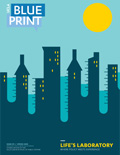THE HISTORY OF MACARTHUR PARK is that of the nation in miniature.
The park was a mudhole when the City of Los Angeles took it over in the 1880s, but an aggressive reclamation project and a natural spring brought it to life. In 2007, it became known for a notorious melee with the Los Angeles Police Department, when protesters demanding amnesty for undocumented immigrants spilled outside park boundaries and the LAPD swooped in, displaying some old habits of violence that many had hoped were buried. Today, sidewalk vendors peddle toys, housewares, churros and bacon-wrapped hot dogs at the park, just down the street from Langer’s Delicatessen. The park hums with the languages of Los Angeles — Chinese, Japanese, Korean, Tagalog, English and especially Spanish.
MacArthur Park also is the home of UCLA’s Labor Center, an instrumental and vital host to L.A.’s labor movement, which has upended the politics of California and established new models for organizing workers and projecting their political power. Thanks to a $15 million grant from the state of California, the center will renovate its downtown headquarters at 675 South Park View Street, one block off the park, and embark on an earthquake retrofit. The project commences this fall. UCLA has purchased the building, which it had rented for 19 years, and the grant will add an elevator and other improvements to comply with requirements to assist the disabled.
The new, permanent offices will be named for James Lawson, a longtime labor and civil rights leader who did pioneering work in Nashville before moving to Los Angeles in the 1970s, bringing with him his fusion of commitments to economic justice, civil rights and pastoral leadership. The renovation marks a milestone in the life of the city’s labor movement and in the history of the Labor Center itself — immersed in L.A.’s immigrant life and in the struggles and triumphs of work and family, at just the moment when those communities are emerging from a bitter year of battling COVID-19 and its economic fallout. These communities represent the Los Angeles of the future; the Labor Center is attempting to anticipate that future and to help lead the way into it.
Kent Wong and the Labor Center
The predecessors of the UCLA Labor Center and its counterpart at UC Berkeley were founded in 1945 by Earl Warren, a Republican governor who viewed himself as heir to the state’s progressive tradition championed by Hiram Johnson. Warren was ambivalent about labor. He courted its support but was wary of its connections to the Democratic Party. The centers reflected those tensions. They focused on California’s interest in industrial development as well as on studying workers and their interests, without fully committing to organized labor. Programs at both universities were styled as studies of industrial relations.
That shifted in 1964, under Democratic Gov. Pat Brown, when UCLA created the Center for Labor Research and Education. The center continued to evolve through the ensuing decades. It tackled questions such as labor organization, wages, unemployment and job discrimination — issues of concern to traditional unions, both then and now.
Kent Wong, a veteran of the Service Employees International Union and graduate of the Peoples Law School in Los Angeles, joined the UCLA center in 1991. During his tenure at SEIU, the Los Angeles chapter of the union helped lead the Justice for Janitors campaign. It also strove to organize home health care workers. Both efforts focused on low-wage, largely immigrant groups. These were novel departures for organized labor. “SEIU was a very dynamic union that was charting a new course for the labor movement here in Los Angeles,” Wong said recently.
Wong was recruited by the UCLA Labor Center during his time at SEIU and accepted, he said, because it offered him the opportunity to work “not just with one union, but to work with dozens and dozens of unions” and allowed him to combine his interests in teaching, research and direct action. His tenure has validated that decision.
Under his directorship, the center has vastly expanded its staff, programs and ambitions, and has become deeply involved in the larger labor movement of Los Angeles. The center has grown from three staff members to more than 30, and UCLA graduated 100 students last year who majored or minored in labor studies. The majority of students taking the center’s courses are women, people of color or first-generation college students.
Many of those students find their way directly into the work of the labor movement, either through the center’s Community Scholars Programs or by contributing to research around immigration, wages or other labor-related issues. In campaigns such as the struggle for a living wage, the center “participated and … lent scholarly support,” said Madeline Janis, a longtime Los Angeles and national labor leader, adding that the “voice of the university” was also useful in securing the attention of officials and others outside of labor.
State Sen. Maria Elena Durazo, former director of the Los Angeles County Federation of Labor and a pioneering organizer, said the center has provided students, energy and research to the movement in Los Angeles. It is, she said, “the biggest thrill for us to have UCLA in that working-class community” at MacArthur Park. Durazo carried the bill that secured the center its renovation funding.
The importance of the center’s work has been underscored by the stresses imposed over the past year because of COVID-19 and its impact on large swaths of Los Angeles. “The UCLA Labor Center has made historic contributions to working-class communities, immigrants and communities of color, who have faced the most severe consequences and mortality rates from the COVID pandemic,” County Supervisor Hilda Solis, a former U.S. Secretary of Labor, said in a motion supporting Durazo’s bill. “They pivoted to address the urgent needs of workers and their families in Los Angeles by providing invaluable research for L.A. County on issues affecting essential workers.”
The center and the movement
As the center has deepened its relationship with the Los Angeles labor movement, it has both helped lead and been able to study a transformative moment in the history of American politics and labor. Once a solidly Republican city and county, Los Angeles has increasingly moved to absorb the values of its immigrant constituencies and their connections to labor.
Campaigns centered in Los Angeles in recent years have included national movements to solidify the legal status of Dreamers, children brought to this country illegally by their parents; efforts to secure a living wage and raise the federal minimum wage; and struggles to improve working conditions and environmental protections at the Los Angeles port and elsewhere. One powerful result is that Los Angeles has shifted the image of a union worker in today’s America: Once a gruff steelworker in Pittsburgh or a miner in West Virginia, the image is now of a single mother working in cleaning services at a California hotel or of a recent immigrant tending to patients in their Central Valley homes.
These changes were wrought in part by a new approach to organizing in L.A. Rather than concentrating on single votes at single companies, Los Angeles organizers have broadened their campaigns to include church and community groups and to think more expansively about the interests of families, from schools to parks to safety. They have used leverage with local governments to gain strength, and they moved from specific campaigns to movement politics. Labor in Los Angeles has evolved from organizing factories for wages and benefits to acting as a centralizing force for communities of workers to protect themselves and maximize their influence. As labor’s range of vision has expanded, so have its ambitions.
This has not been lost on the national labor movement, though some of its leaders continue to resist the lessons of Los Angeles. In decline nationally, labor’s base has been eroded by the disruption of heavy industries, such as steel and mining. Organized labor has grudgingly acknowledged L.A. as a powerful counter-example, a place where labor is ascendant, not by having redoubled its efforts in fading industries but by expanding its message and reaching into new communities. Nevertheless, many national labor leaders have hesitated to grasp the significance of that change.
Confident that it is right, L.A. is charting a new course. “Los Angeles has emerged as the focal point,” Wong said, ”for the new American labor movement.” Duarzo agrees — but acknowledges that not all national leaders have gotten the word. She warns: “The labor movement nationally cannot succeed if we exclude immigrant workers or any workers of color.”
Emphasis on those workers has added to labor’s growth in Los Angeles, and one result has been the increase of its political might. In many parts of California today, it is nearly impossible to win or hold office without the support of at least some elements of organized labor. (As a large movement, its components do not always work in lock-step. Prison guards, for instance, may not hold the same priorities as schoolteachers or hotel workers.)
As Wong puts it, labor is largely responsible for transforming California from a purple state into a blue state. In today’s California, every statewide elected official is a Democrat, and the vast majority of them are supported by labor. Majorities of the Los Angeles County Board of Supervisors and the Los Angeles City Council are labor-backed Democrats.
“We have succeeded,” Durazo said, ”in changing the politics of Los Angeles.”
Not everyone likes that, but no one denies it.
THE LABOR CENTER’S DOWNTOWN HEADQUARTERS is within walking distance of more than 20 labor union offices. It is a hub of organizing, a model of “engagement with Los Angeles,” said Abel Valenzuela, professor of Chicana/o studies and urban planning and director of UCLA’s Institute for Research on Labor and Employment. “That’s something UCLA has been articulating for a long time.”
Indeed, UCLA’s mission often is described as threefold: teaching, research and community engagement, the last being fundamental to the notion of a public university. Yet the Labor Center’s work sometimes attracts quiet misgivings. Why, some officials ask (though none publicly), should UCLA help to support a movement with such overt political aspirations?
To which supporters of the center respond: Labor communities are at the heart of L.A.’s future, and what would engagement be if not attempting to understand and advance their interests? As Valenzuela noted, “What we’re doing is the will of the people.”
Editor’s Note: A version of this article appears in UCLA Magazine’s fall issue.

























